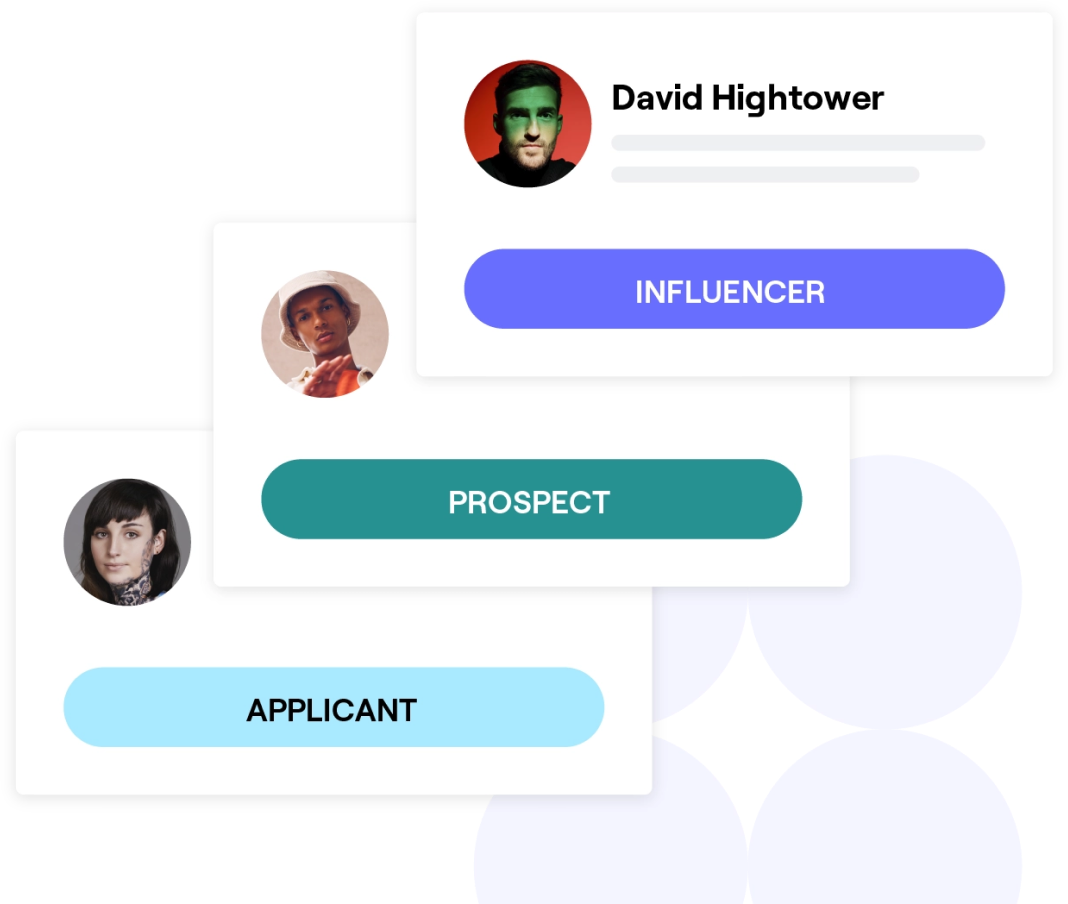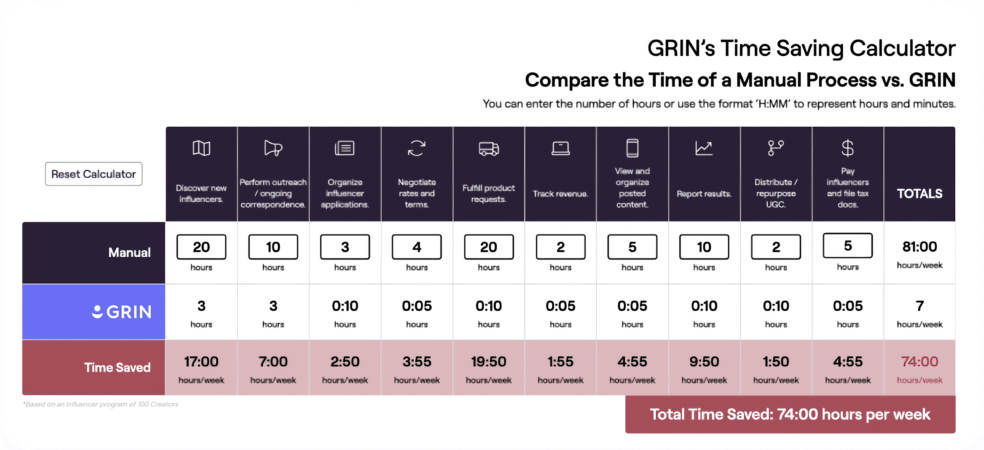The art of negotiation is more valuable than ever as influencer rates continue to rise across most platforms. Today, marketers must have a negotiation strategy in place before outreach begins and be fully aware of all factors that play into a rate that works well for both parties.
In this blog, we’ll introduce some tips and tricks to consider when you head into your next influencer negotiation and help you nail down a foolproof strategy for landing your dream partnership.
Common campaign and compensation types
Before you launch into negotiation, make sure you have an understanding of the different compensation options. You might find one that works better than others, but most successful campaigns leverage some combination of all three.
Product seeding
Giving creators free products or samples in exchange for content is known as product seeding. It’s the most cost-effective compensation method since hiring a creator is only as expensive as your cost of goods sold.
Enabling creators to try your product and learn about your company before promoting it is also a great way to build brand love and generate more authentic product endorsements.
The types of creators most likely to accept products as payment include:
- Customer advocates.
- Brand ambassadors.
- Nano influencers.
- Micro influencers.
“For our [first-tier] influencers, we’re just gifting products. And we always start everyone there just to make sure they’re a good fit with the brand. I would never feel comfortable paying anyone that didn’t sincerely love the brand. I never want to pay someone who hasn’t used the product.”
— Andrea Faulkner Williams, founder of Tubby Todd, Tubby Todd Bath Co. + GRIN
Commission
Many brand-influencer relationships thrive on a profit-sharing basis. Also known as an affiliate model, paying commissions to your creators helps lower upfront costs while motivating your creators to generate conversions.
If sales are the primary objective of your influencer program, you may want to use an affiliate model as your primary payment structure. However, be sure to select creators who will remain authentic when implementing this strategy, so your content doesn’t come across as “salesy.”
An affiliate model is most common with:
- Brand ambassadors
- Nano influencers
- Micro influencers
Flat fee
A flat-rate payment arrangement requires a pay-per-post structure. The cost of each post may vary from less than $10 to thousands of dollars. But there are some common scenarios where paying for each influencer post may be your best approach.
Scenario 1
Outsource social content to trusted creators who consistently produce higher quality content than anything you can make in-house. Because this brand-influencer relationship is strong, you can verify ROI before payout. These posts also work well for repurposed content in paid ads, email, and other production costs that you would have had regardless.
Scenario 2
The pay-per-post model is standard and usually makes more sense when you partner with influencers with larger audiences. Before you invest in these macro and celebrity influencers, it’s important to check the quality of their engagement. A suspiciously low or high engagement rate could mean a big chunk of the creator’s following are bots or fake accounts.

How much do influencers actually cost?
Many influencer marketing managers don’t feel confident in their knowledge of “what a fair price is” when negotiating with influencers, and with good reason—there really is no standard cost for content creators.
That said, it’s always reasonable to assume that the larger a creator’s audience, the more they will charge for partnerships. While nano and micro influencers might be open to creating content in exchange for free products, macro and celebrity influencers will almost certainly command a price tag too hefty for bootstrapped brands.
Because there’s no one answer to the question, “How much do influencers cost?” you must treat each creator negotiation as an isolated collaborative moment between the influencer and your brand. The more clearly you can define your budget and your expectations, the better you will know whether or not the cost of a particular influencer is realistic. It may be that the best partnerships cost you a few thousand dollars per post, while others cost you almost nothing at all (in terms of dollars and cents).
Developing your compensation strategy
Be sure to have a strategy together before entering any creator negotiation. Here are some things to consider.
1. Know your numbers.
Be aware of what you can afford. If you’re negotiating a flat rate, have a maximum number in your head, and don’t exceed it. If it becomes clear that you and your creator won’t be able to come to a rate that works for both parties, don’t be afraid to politely end the negotiation.
Some other important numbers to keep in mind include:
Your ideal creator engagement rate.
- Pieces of content created.
- Length of partnership.
- A total number of conversions generated.
2. Ask the creator what their rate is first.
Creator rates can be all over the map. By asking your prospect what their rate is first, you can get a solid jumping-off point and a better idea of whether negotiating with that creator will be worth your time.
3. Adjust the campaign specifics (type and number of posts).
If a creator’s rate is out of your budget, see if you can adjust the campaign requirements to come to an agreement. A creator might be willing to lower their rate if you can accept a shorter partnership or fewer posts and still reach your campaign goals.
4. Leverage additional perks.
Come prepared with additional perks and incentives you can offer your creator to help sweeten the deal during negotiation. If you’re *this close* to sealing the partnership but can’t quite get over the hump, a simple gift could be all it takes to get there.
5. Be transparent about what you can afford.
Be upfront with your creator if your brand is strapped for cash. If they truly love your products and overall vision, they’ll likely be willing to work something out. But you have to be honest. Creators are savvy and know the difference between “we don’t have the budget” and “we don’t want to pay you.”
How to deal with creators: 11 tips to consider during influencer negotiation
1. Be specific on content.
Ambiguity is a recipe for poor communication and relationships. However, using specific language allows everyone involved in negotiations to understand and respond.
As such, your influencer negotiation should address content specifics including, but not limited to:
- Campaign and post timeline.
- Information to include in each post.
- Post frequency.
- Post timing
- Content type (text, static image, video, blog, etc.).
- Expected engagement.
2. Discuss content usage rights.
Content usage rights are included in customizable agreement templates for brands using GRIN’s Creator Management platform. But those operating with a manual approach to influencer marketing must draw their own contracts to ensure they have all the permissions necessary to use influencer content.
Keep in mind that content usage rights should address post ownership and the timeframe within which a brand may leverage over a particular post (or batch of posts).
3. Keep repurposed content in mind.
Ideally, you want creator content that can perform across multiple campaign types. For example, a high-performing influencer post makes great branded posts (sharing and shout-outs) and digital ads.
Getting more mileage from a creator’s post can also include adding that content to your company website, email blasts, and even SMS marketing content. Repurposing content in this way reduces your graphic design costs.
In real life (IRL) deals encompass content repurposing, as well as tighter partnerships with your creators. IRL agreements involve endorsements, event appearances, and more.
Either way, thinking beyond the next creator campaign allows your marketing budget to accomplish more with less. Should a particular creator charge slightly more than you expected, a plan to repurpose that content lowers marketing expenses elsewhere.
4. Prepare for contingencies.
At the risk of overthinking the negotiation process, you must discuss common “what if” moments with your creators. If you or the creator suggests an unreasonable plan, bringing these contingencies out in the open can expose unsustainable terms.
In addition to these front-facing conversations, consider internal contingencies you may want to keep to yourself in discussions with your creators. Anticipate possible responses and come to negotiations armed with alternative suggestions and logical arguments.
5. Talk about brand exclusivity.
These conversations are critical if you want to ensure your creators aren’t endorsing any of your competitors during your partnership. As such, broaching the exclusivity discussion means you must have something valuable to give the creator. If they are to refrain from doing business with other brands, your offer will need to be clear and compelling.
6. Ensure non-disclosure.
You and your creator must have an understanding of what is public and what is private. During negotiations, both parties will have specific non-disclosure demands. It’s wise to include your legal team regarding contracts and language that you must use to ensure confidentiality with your partners.
7. Define engagement expectations.
Discuss expectations for your creators’ engagement rates before making the partnership official. Remember that this metric directly reflects the creator’s relationship with their audience. If they aren’t willing to commit to a particular engagement rate, they might drop their price if you agree to lower your expectations slightly—just don’t lower them too much!
8. Anticipate more negotiating for Instagram takeovers and creator licensing campaigns.
It’s one thing to partner with a creator for a campaign or a series of campaigns. But suppose you want to execute an Instagram takeover or creator licensing campaign. In that case, you’re asking for a certain level of control over their social media account—a tall order for some creators.
As such, you should only recommend these campaign approaches if you and the creator already have a strong working relationship. Additionally, you should come prepared to “sweeten the pot,” whether in higher pay or better perks (or both).
9. Discuss short-term versus long-term partnerships.
If a creator suggests a price outside your budget, you can often give a counteroffer lower than their rate while giving additional context to your budget and explaining how your other creator relationships generally work. By informing a creator of your desire for a long-term partnership, that influencer may feel comfortable dropping their rate in favor of an extended collaboration.
10. Seal the deal with perks and incentives.
If you’re on the cusp of securing a partnership with the perfect creator but can’t quite seal the deal, see if adding an extra perk or incentive helps seal the deal.
If your price point allows, this could mean something as simple as a free product prior to onboarding. Elevating the creator to a higher affiliate commission model could do the trick for larger-ticket items. And if you still haven’t nailed down the partnership, you might consider offering the creator “ambassador” status to make them an even more integral part of your team and future success.
11. Don’t be afraid to renegotiate with your top-performing influencers.
After running a handful of influencer campaigns, your top creators may ask to revisit terms for future campaigns. If this happens, don’t be afraid to renegotiate.
You both want the same thing—to help one another achieve your respective goals. By asking more from your brand, you will also be able to ask more of your creators. And if a creator wants compensation beyond your preferred rate, suggest additional perks or alter campaign specifics until both parties are satisfied.
Key takeaway: Strong, long-term creator relationships start at the negotiation table.
Negotiating influencer rates can be a nerve-wracking experience, but with a strategy in place and the right tools at your disposal, you should have everything you need to seal the deal. Stay true to your budget, and don’t be afraid of a little haggling. Be confident in your brand and, most importantly, yourself!
Learn more about influencer marketing: Influencer Marketing 101

















